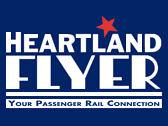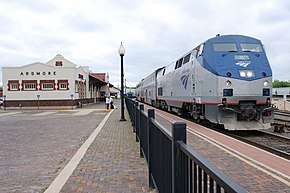Heartland Flyer
The Heartland Flyer is a daily passenger train that follows a 206-mile (332 km) route between Oklahoma City, Oklahoma and Fort Worth, Texas. It is operated by Amtrak and jointly funded by the states of Oklahoma and Texas.[2] The train's daily round-trip begins in Oklahoma City in the morning and reaches Fort Worth in the early afternoon. It leaves Fort Worth during the afternoon rush for an evening return to Oklahoma City. As of November 2014, the train is scheduled at 3 hours 58 minutes in each direction.[3]
| Heartland Flyer | |||||||||||||||||||||||||||||||||||||||||||||||||||||||||||||||||||||||||||||||||||||||||||||||||||||||||||||||||||||||||||||||||||||||||||||||||||||||||||||||||||||||||||||||||||||||||||||||
|---|---|---|---|---|---|---|---|---|---|---|---|---|---|---|---|---|---|---|---|---|---|---|---|---|---|---|---|---|---|---|---|---|---|---|---|---|---|---|---|---|---|---|---|---|---|---|---|---|---|---|---|---|---|---|---|---|---|---|---|---|---|---|---|---|---|---|---|---|---|---|---|---|---|---|---|---|---|---|---|---|---|---|---|---|---|---|---|---|---|---|---|---|---|---|---|---|---|---|---|---|---|---|---|---|---|---|---|---|---|---|---|---|---|---|---|---|---|---|---|---|---|---|---|---|---|---|---|---|---|---|---|---|---|---|---|---|---|---|---|---|---|---|---|---|---|---|---|---|---|---|---|---|---|---|---|---|---|---|---|---|---|---|---|---|---|---|---|---|---|---|---|---|---|---|---|---|---|---|---|---|---|---|---|---|---|---|---|---|---|---|---|
 | |||||||||||||||||||||||||||||||||||||||||||||||||||||||||||||||||||||||||||||||||||||||||||||||||||||||||||||||||||||||||||||||||||||||||||||||||||||||||||||||||||||||||||||||||||||||||||||||
 The southbound Heartland Flyer at Ardmore, Oklahoma in 2007 | |||||||||||||||||||||||||||||||||||||||||||||||||||||||||||||||||||||||||||||||||||||||||||||||||||||||||||||||||||||||||||||||||||||||||||||||||||||||||||||||||||||||||||||||||||||||||||||||
| Overview | |||||||||||||||||||||||||||||||||||||||||||||||||||||||||||||||||||||||||||||||||||||||||||||||||||||||||||||||||||||||||||||||||||||||||||||||||||||||||||||||||||||||||||||||||||||||||||||||
| Type | Inter-city rail | ||||||||||||||||||||||||||||||||||||||||||||||||||||||||||||||||||||||||||||||||||||||||||||||||||||||||||||||||||||||||||||||||||||||||||||||||||||||||||||||||||||||||||||||||||||||||||||||
| System | Amtrak | ||||||||||||||||||||||||||||||||||||||||||||||||||||||||||||||||||||||||||||||||||||||||||||||||||||||||||||||||||||||||||||||||||||||||||||||||||||||||||||||||||||||||||||||||||||||||||||||
| Status | Operating | ||||||||||||||||||||||||||||||||||||||||||||||||||||||||||||||||||||||||||||||||||||||||||||||||||||||||||||||||||||||||||||||||||||||||||||||||||||||||||||||||||||||||||||||||||||||||||||||
| Locale | Oklahoma and Texas | ||||||||||||||||||||||||||||||||||||||||||||||||||||||||||||||||||||||||||||||||||||||||||||||||||||||||||||||||||||||||||||||||||||||||||||||||||||||||||||||||||||||||||||||||||||||||||||||
| Termini | Oklahoma City, Oklahoma Fort Worth, Texas | ||||||||||||||||||||||||||||||||||||||||||||||||||||||||||||||||||||||||||||||||||||||||||||||||||||||||||||||||||||||||||||||||||||||||||||||||||||||||||||||||||||||||||||||||||||||||||||||
| Stations | 7 | ||||||||||||||||||||||||||||||||||||||||||||||||||||||||||||||||||||||||||||||||||||||||||||||||||||||||||||||||||||||||||||||||||||||||||||||||||||||||||||||||||||||||||||||||||||||||||||||
| Daily ridership | 213 | ||||||||||||||||||||||||||||||||||||||||||||||||||||||||||||||||||||||||||||||||||||||||||||||||||||||||||||||||||||||||||||||||||||||||||||||||||||||||||||||||||||||||||||||||||||||||||||||
| Ridership | 66,105 total (FY16)[1] | ||||||||||||||||||||||||||||||||||||||||||||||||||||||||||||||||||||||||||||||||||||||||||||||||||||||||||||||||||||||||||||||||||||||||||||||||||||||||||||||||||||||||||||||||||||||||||||||
| Train number(s) | 821, 822 | ||||||||||||||||||||||||||||||||||||||||||||||||||||||||||||||||||||||||||||||||||||||||||||||||||||||||||||||||||||||||||||||||||||||||||||||||||||||||||||||||||||||||||||||||||||||||||||||
| Operation | |||||||||||||||||||||||||||||||||||||||||||||||||||||||||||||||||||||||||||||||||||||||||||||||||||||||||||||||||||||||||||||||||||||||||||||||||||||||||||||||||||||||||||||||||||||||||||||||
| Opened | June 14, 1999 | ||||||||||||||||||||||||||||||||||||||||||||||||||||||||||||||||||||||||||||||||||||||||||||||||||||||||||||||||||||||||||||||||||||||||||||||||||||||||||||||||||||||||||||||||||||||||||||||
| Owner | BNSF Railway (track) | ||||||||||||||||||||||||||||||||||||||||||||||||||||||||||||||||||||||||||||||||||||||||||||||||||||||||||||||||||||||||||||||||||||||||||||||||||||||||||||||||||||||||||||||||||||||||||||||
| Operator(s) | Amtrak | ||||||||||||||||||||||||||||||||||||||||||||||||||||||||||||||||||||||||||||||||||||||||||||||||||||||||||||||||||||||||||||||||||||||||||||||||||||||||||||||||||||||||||||||||||||||||||||||
| Rolling stock | Superliner Coaches | ||||||||||||||||||||||||||||||||||||||||||||||||||||||||||||||||||||||||||||||||||||||||||||||||||||||||||||||||||||||||||||||||||||||||||||||||||||||||||||||||||||||||||||||||||||||||||||||
| Technical | |||||||||||||||||||||||||||||||||||||||||||||||||||||||||||||||||||||||||||||||||||||||||||||||||||||||||||||||||||||||||||||||||||||||||||||||||||||||||||||||||||||||||||||||||||||||||||||||
| Line length | 206 miles (332 km) | ||||||||||||||||||||||||||||||||||||||||||||||||||||||||||||||||||||||||||||||||||||||||||||||||||||||||||||||||||||||||||||||||||||||||||||||||||||||||||||||||||||||||||||||||||||||||||||||
| Track gauge | 1,435 mm (4 ft 8 1⁄2 in) | ||||||||||||||||||||||||||||||||||||||||||||||||||||||||||||||||||||||||||||||||||||||||||||||||||||||||||||||||||||||||||||||||||||||||||||||||||||||||||||||||||||||||||||||||||||||||||||||
| |||||||||||||||||||||||||||||||||||||||||||||||||||||||||||||||||||||||||||||||||||||||||||||||||||||||||||||||||||||||||||||||||||||||||||||||||||||||||||||||||||||||||||||||||||||||||||||||
The Heartland Flyer carried over 77,000 passengers in fiscal year 2016, a 4.2% decrease from FY2015. The train had a ticket revenue of $1,828,486, an increase of 1.8% from FY2015.[1] Total revenue for the train, including state-level subsidies to Amtrak, was approximately $7.1 million[4]
History and funding

At Amtrak's formation in 1971, the corridor was served by the railroad's Chicago–Houston Lone Star, itself the successor of the Santa Fe's Texas Chief. However, the Lone Star was discontinued in 1979, severing the state of Oklahoma from the national rail network. The Heartland Flyer was inaugurated on June 14, 1999, ending a 20-year absence of passenger rail in Oklahoma and North Texas. Senator Don Nickles sponsored a "Name the Train" contest, encouraging Oklahoma schoolchildren to pick a name for the new route. The winning name was submitted by Katie Moore, who christened the new train on its first run.[5][6]
First-year ticket sales totaled 71,400 passengers, more than double Amtrak's projection of 20,000 riders.[7] The Heartland Flyer carried 68,000 passengers during FY 2007. In September 2007 it had carried 500,000 passengers since its inception,[8] and in November 2013, it carried its millionth passenger.[9]
The temporary federal funding for the service was used up by 2005. However, regional passenger rail advocates came out in force on April 11, 2005, for a state capitol rally sponsored by PassengerRailOk.org. Keynote speaker, Oklahoma City Mayor Mick Cornett addressed the crowd along with the mayors of Perry, Guthrie, and Purcell, Oklahoma, encouraging the state fund the service and to expand the train into Kansas.[10] State lawmakers kept the Heartland Flyer in operation by passing House Bill 1078 that provided an annual $2 million subsidy to continue the service.[11]
Equipment used
Locomotives commonly used on the Heartland Flyer include the General Electric P42DC and P32-8WH. It uses Superliner railcars. For many years, the train was powered by only one locomotive, and a Non-Powered Control Unit (NPCU) on the end of the train opposite the locomotive made the train bi-directional. In 2009, the NPCU was replaced with a standard Genesis P42DC, giving the train locomotive power on both ends.
From April 2010 to April 2011, Amtrak and the Oklahoma Department of Transportation carried out a research project to run the train on a biodiesel blend known as B20 (20% pure biofuel and 80% diesel). P32-8 locomotive No. 500 carried an Amtrak decal indicating the use of this fuel.[12] The test made national news when TIME magazine listed it as one of "The 50 Best Inventions of 2010."[13]
Connections
The train connects to Amtrak's national passenger rail network at Fort Worth Central Station, where it is timed to allow transfers to the Texas Eagle in both directions. The Texas Eagle runs daily between Chicago, Illinois and San Antonio, Texas, and continues three days each week to Los Angeles, California. TEXRail commuter rail runs daily to Dallas/Fort Worth International Airport via transfer at Fort Worth Central (with additional connections to Dallas Area Rapid Transit Light Rail). The Trinity Railway Express commuter rail service also runs from Fort Worth to nearby Dallas Monday through Saturday each week, with roughly hourly service on weekdays and service every two hours on Saturday.
The Fort Worth station also has connections to many local buses operated by Trinity Metro and intercity buses operated by Greyhound Lines.
Every October, the Oklahoma Department of Transportation adds an extra coach to accommodate fans attending the Red River Showdown in Dallas. Shuttle buses run between Fort Worth Central and Dallas hotels, and pick them up for the return trip to Oklahoma.[5]
Expansion proposals
Several proposals for extending the route of the Heartland Flyer, or providing additional service over all or parts of its route, have been made over the years. Expansion planning revolves around portions of the former Lone Star route; as well as the line between Oklahoma City and Tulsa, Oklahoma. The only concrete proposal regarding the OKC–Tulsa line, the Eastern Flyer, fell through in August 2019 when the Stillwater Central Railroad, purchaser of the line from the State of Oklahoma, opted to default under its agreement with the State and pay the contractual $2.8 million penalty for not establishing passenger rail service.[14]
The line to Kansas City would stop at Wichita's Union Station and follow the route of the Southwest Chief north of Newton, Kansas. Recent interest in Kansas and Oklahoma communities has been sparked by the proposal and many towns have released resolutions supporting the idea and requesting stations should the route ever be extended. Some of these cities include Wichita, which lost its train service with the discontinuance of the Amtrak Lone Star in 1979. Emporia was eliminated as an Amtrak stop in 2000 but may once again have a train station. Nearly a dozen other communities ranging in size from the tiny community of Strong City, Kansas (pop. 570), to Wichita, with nearly 358,000 residents have passed these resolutions.
A study conducted by Amtrak in 2009 resulted in four proposed service extensions:[15]
- Extend the current train north to Newton, Kansas, where passengers could connect with the Southwest Chief to both Chicago and Los Angeles, which stops in Newton in the middle of the night.
- Add a second day train from Fort Worth to Kansas City, which would offer twice daily service over much of the route but wouldn't connect with other trains.
- A variation of the first plan would extend the overnight train to Kansas City.
- A variation of the second plan would terminate the day train at Oklahoma City, rather than operating all the way to Texas.
According to the August 2010 issue of Trains Magazine, a combination of options one and two as noted above is not out of the question, either, allowing for day and night service, plus perhaps thru-car service to/from the Southwest Chief.[15]
In late 2011, the Kansas Department of Transportation released the results of a study into new service south to Fort Worth, presenting the options of a night train from Texas to Newton, with start-up costs of $87.5 million and an annual subsidy of $4.4 million, or a day train to Kansas City, with start-up costs of $245.5 million and an annual subsidy of $10 million.[16]
During the 1990s, service to San Antonio, Texas, via Austin in conjunction with a reroute of the Texas Eagle west from Fort Worth to El Paso, Texas via Sierra Blanca was considered. This would have created another connection with the Sunset Limited.[17]
Part of the route used by the Heartland Flyer is designated by the USDOT as the South Central High Speed Rail Corridor and is slated to be upgraded to high-speed rail service should funding ever become available. The corridor extends from San Antonio, Texas, to Tulsa through Fort Worth and Oklahoma City. Another branch of this corridor extends from Fort Worth through Dallas to Little Rock, Arkansas.[18]
References
- "Amtrak FY16 Ridership and Revenue Fact Sheet" (PDF). Amtrak. April 17, 2017. Retrieved February 21, 2018.
- "Information Release 07-016" (PDF) (Press release). Oklahoma Department of Transportation. March 21, 2007. Archived from the original (PDF) on October 26, 2007. Retrieved August 12, 2007.
- "Texas Eagle and Heartland Flyer timetable" (PDF). Amtrak. November 2, 2014. Retrieved February 21, 2015.
- "Monthly Performance Report for September 2016" (PDF). Amtrak. November 12, 2014. p. 41. Retrieved February 21, 2015.
- Heartland Flyer history
- Gordon Dickson (June 18, 2019). "Amtrak's Heartland Flyer runs from Fort Worth to OKC. How did the train get its name?". Fort Worth Star-Telegram.
- Cooper, Aaron (June 14, 2000). "Amtrak, ODOT celebrate 1-year anniversary of Heartland Flyer". Associated Press. Retrieved April 28, 2008.
- "Ridership up on Heartland Flyer". Associated Press. November 9, 2007. Retrieved April 28, 2008.
- "Amtrak recognizes OSU student as millionth passenger on Heartland Flyer". The Oklahoman. November 15, 2013. Retrieved November 16, 2013.
- Talley, Tim (April 11, 2005). "Rail passengers rally for Heartland Flyer". Associated Press.
- Price, Marie (May 25, 2005). "Beefed-up state agency budgets sent to governor". Tulsa World. p. A10.
- "Heartland Flyer". Amtrak History & Archives. Retrieved October 3, 2014.
- "Amtrak's Beef-Powered Train". TIME Magazine. November 11, 2010. Retrieved October 3, 2014.
- "OKC-to-Tulsa passenger rail service falls through". Randy Ellis, Tulsa World, August 6, 2019. Retrieved August 6, 2019.
- Bob Johnston (August 2010). "Kansas weighs new train choices". Trains Magazine. Kalmbach Publishing.
- "Kansas DOT releases passenger-rail service development plan". Progressive Railroading. December 5, 2011. Retrieved December 6, 2011.
- "Fort Worth-Los Angeles Proposed Schedule Change Updated October 27, 1999". Texas Association of Rail Passengers. October 27, 1999. Archived from the original on September 29, 2007.
- "South Central Corridor". USDOT. Archived from the original on October 12, 2012. Retrieved October 21, 2012.
External links
| Wikimedia Commons has media related to Heartland Flyer. |